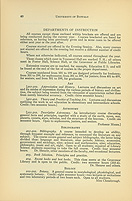Flashback
85 years ago
UB originates ‘101’ course numbering
The frequent use of “101” in a humorous context is widely understood to refer to the most basic or elementary facts about a subject. There is Singing 101, Skiing 101 and Money 101. How about Pumpkin Carving 101 or Rocket Science 101? Anyone for Fast Seduction 101? Available to guide us through life are Childbirth 101, Living 101 and the necessary Dying 101.
According to Daniel Engber, author of the 2006 Slate magazine article titled “101 101: How Did Intro Classes Get Their Trademark Number?” the first known use of “101” in a humorous sense occurred in the early 1960s when Woody Allen said in a comedy routine, “I took all the abstract philosophy courses in college, like truth and beauty, advanced truth and beauty, intermediate truth, introduction to God, Death 101.”
A researcher at another institution recently contacted staff members in the UB Archives and asked if we could confirm that the widely used numbering scheme for college courses (100s and 200s for lower level courses and 300s and 400s for upper level) originated at UB. The researcher referred to Engber’s article and his source, the universally accepted authority on English language, the “Oxford English Dictionary,” or OED for short.
The prospect of “101” having been invented at UB sent Archives’ staff scurrying to the OED. Yes, UB was indeed credited with originating the course-numbering scheme and, therefore, enabling the subsequent use of “101” in countless amusing ways. But the Archives staff wasn’t satisfied with the OED’s entry for “101” and its claim that the first occurrence of the course-numbering scheme was in the “University of Buffalo Bulletin” dated Dec. 1, 1929. Staff members discovered that the first use by UB occurred five years earlier in 1924, and that the “Bulletin” for that year also included, for the first time, a description of the numbering scheme. A correction was rushed to the editors of the OED, who agreed to change the entry for “101” the next time they review that section of the publication.
The need to correct the “the accepted authority on the evolution of the English language over the last millennium,” as the OED describes itself, caused the Archives staff to doubt whether “101” did, in fact, originate at UB. If OED had the wrong date, maybe it had the wrong institution, too. Thus far, nothing has been located in the historical records of the College of Arts and Sciences or in any other collection available in the Archives documenting that someone at UB conceived this method of distinguishing elementary courses from advanced ones, but neither has anything been located indicating that UB copied the idea from another institution.
Until proven otherwise, let’s assume that 85 years ago, UB originated the now-standard way of numbering college courses that eventually resulted in popular usage—such as the course for our own incoming students, “UB 101.”
—John Edens, University Archives


Reader Comments